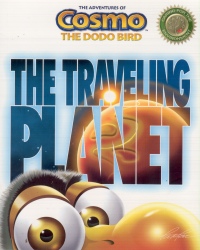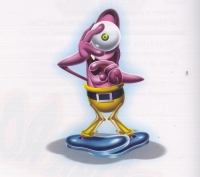| ________________
CM . . . . Volume XVIII Number 6 . . . . October 7, 2011
excerpt:
The Traveling Planet is the second instalment in the series entitled "The Adventures of Cosmo the Dodo Bird." That being said, this book can act as a standalone publication as it includes a description of both of the main characters, Cosmo and 3-RV, and the plot on the opening pages. The book does refer to the first title in the series, The Quest of the Last Dodo Bird, by having Cosmo remember back through comic strips which introduces the reader to characters from the first title in this series. There are at least two other titles released in the English translation following this book, as well as four other books aimed at younger readers.
The characters are positively wacky, making this story enjoyable. The helmet-wearing Diggs is cranky and single-mindedly obsessed with becoming, "Rich, Rich, RICH!" Two-Heads is a two-headed creature that argues with itself constantly, with the left taking an artistic approach to life and the right a scientific. Fabrico is a compliant worker that is "...not paid to think" about the effects of his actions. The text is very accessible. The sentences are short, and the text is provided in small chunks and divided into 13 short chapters (~4 full pages/chapter). In addition, the print is a large, simple font which makes it very readable. The text, mostly dialogue with little narration, makes the story very adaptable to a comic strip format. The accompanying graphic illustrations are colourful and kooky, just like the stories' characters. The cartoon illustrations are the most appealing aspect of this book. Illustrations occur on almost every page and take up most pages with the text layered on top in white. The pictures add to the story by providing the characters' emotions through the use of large eyes and faces. They also present much more detail of the setting than does the text alone. The text could not stand alone in this work as the illustrations really add to the overall appeal of the story. The Traveling Planet could be easily used in the classroom when discussing the topic of the environment as it stresses the consequences of actions and hope for change which may empower young people. Overall, the book does achieve the aim of providing awareness of environmental issues and themes, even though this is not done subtly. Recommended for those children interested in environment sustainability or in the classroom to engage young students with environmental themes. Recommended. Danika Bernard, who lives in Ontario, is a professional librarian.
To comment
on this title or this review, send mail to cm@umanitoba.ca.
Copyright © the Manitoba Library Association. Reproduction for personal
use is permitted only if this copyright notice is maintained. Any
other reproduction is prohibited without permission.
NEXT REVIEW |
TABLE OF CONTENTS FOR THIS ISSUE
- October 7, 2011.
AUTHORS |
TITLES |
MEDIA REVIEWS |
PROFILES |
BACK ISSUES |
SEARCH |
CMARCHIVE |
HOME |

 The story begins with Cosmo, the last dodo bird, and 3R-V, a robot spaceship, travelling through space on a mission to find other dodos. In this story, the adventurous pair comes across a planet that is travelling through space due to an explosive galactic tornado. After landing on this planet, Cosmo comes across both old friends and new. Intertwined with the main plot are mini-stories that explain the characters' backgrounds in relation to their environment. Each of the kooky characters has a background story that is revealed through a comic strip format that involves the theme of environmental damage and the consequences. Fortunately, the characters do learn from their erroneous ways, thereby providing hope. For example, Two-Heads consumes flowers until there is only one left that they must preserve in order to avoid extinction of all flowers on their planet. The mini-stories are didactic in their telling, but the didacticism is offset by the comic strip format which makes them much more entertaining. The main plot ends with an entertaining battle with slobbery monsters. The obvious overall aim of this work is to encourage appreciation of the environment and sustainability through the introduction of how one's actions impact the environment.
The story begins with Cosmo, the last dodo bird, and 3R-V, a robot spaceship, travelling through space on a mission to find other dodos. In this story, the adventurous pair comes across a planet that is travelling through space due to an explosive galactic tornado. After landing on this planet, Cosmo comes across both old friends and new. Intertwined with the main plot are mini-stories that explain the characters' backgrounds in relation to their environment. Each of the kooky characters has a background story that is revealed through a comic strip format that involves the theme of environmental damage and the consequences. Fortunately, the characters do learn from their erroneous ways, thereby providing hope. For example, Two-Heads consumes flowers until there is only one left that they must preserve in order to avoid extinction of all flowers on their planet. The mini-stories are didactic in their telling, but the didacticism is offset by the comic strip format which makes them much more entertaining. The main plot ends with an entertaining battle with slobbery monsters. The obvious overall aim of this work is to encourage appreciation of the environment and sustainability through the introduction of how one's actions impact the environment.